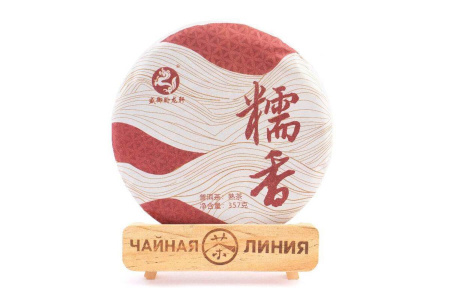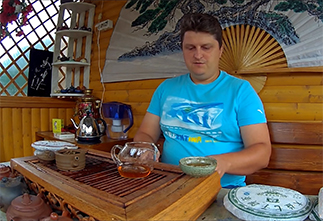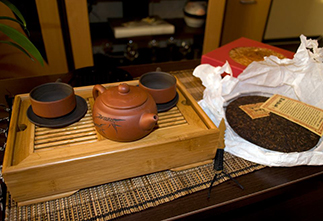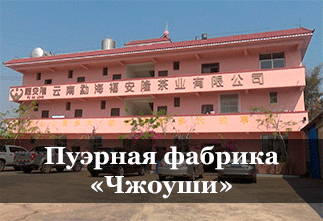Shu Puer "Nomisyan" 2016 from the factory "Zhoushi": Unique taste and aroma
Shu pu-erh "Nomisyan" (Chinese: 糯米香, pinyin nuòmǐ xiāng) 2016 from the Zhoushi plant (周氏, Zhōu shì) is a truly unique tea that attracts the attention of connoisseurs due to its unusual aroma and taste. The name "Nomishan" is translated as "aroma of sticky rice", but this pu-erh has nothing to do with rice. It got its name from the nomi grass, which gives the tea a unique aroma.
Production and composition
This puer is produced in the Xishuangbanna Dai Autonomous Region, famous for its tea plantations. To create this unique taste, tea leaves are mixed with nomi leaves in certain proportions. It is this herb that gives the tea its characteristic aroma and taste.
Taste and aroma
The aroma of this puer is difficult to describe in words. It is very bright, rich and memorable. It combines notes of wood, spices and, of course, nomi. After brewing, the aroma becomes even more intense and reveals new facets.
The taste of the tea is also striking in its complexity. It is sweetish, with a slight bitterness and a pleasant aftertaste. Notes of nomi are clearly felt, which give the tea a peculiar medicinal shade.
Beneficial properties
In addition to its excellent taste, Nomisyan puer has a number of beneficial properties:
- Tones the body: Helps to wake up and recharge with energy.
- Improves digestion: Promotes normal functioning of the gastrointestinal tract.
- Strengthens the immune system: Due to the high content of antioxidants.
- Has a warming effect: Especially useful in the cold season.
How to brew
For brewing Nomisyan puer, it is recommended to use a porcelain gaiwan with a capacity of 150-200 ml. The water temperature should be about 95°C. 5-7 grams of tea is enough for one brew. The brewing time may vary depending on personal preferences.
Who is this tea suitable for?
Puer "Nomisyan" is suitable for those who love unusual tastes and aromas. It will be interesting for both beginners and experienced tea gourmets. Thanks to its warming properties, it is perfect for the cold season.
Shu Puer "Nomisyan" 2016 from the factory "Zhoushi" is a real gift for connoisseurs of Chinese tea. Its unique taste and aroma, as well as useful properties make it an indispensable drink for those who value traditions and seek new taste sensations.
|
Name in Chinese
|
糯米香 |
|
Pinyin
|
Nuòmǐ xiāng |
|
English name
|
Nomisyan |
|
Translation
|
Nomisyan |
|
Country
|
China |
|
District
|
Xishuangbanna Dai Autonomous Prefecture |
|
Provinces
|
Yunnan (云南) |
|
Region
|
Menghai (勐海) |
|
Manufacturer
|
Чжоуши (周氏) |
|
Year of pressing
|
2016 |
|
Pressing form
|
Bing Cha (Cake Tea) |
|
Declared weight, g
|
357 |
|
Tea tree (bush) variety
|
Da Ye Zhong |
|
Length, cm
|
20 |
|
Width, cm
|
20 |
- Комментарии
- Вконтакте
Pu-erh is one of the most unique types of tea, which only gets better with age. Many people, when they first encounter this tea, wondered: why is pu-erh more often found in pressed form (cakes, bricks, tochas), and not in loose form? The reasons for this are related to both history and the practical aspects of storing and fermenting tea. Despite modern technologies that allow the production of loose pu-erh, the shape of pressed cakes remains unchanged. And pu-erh is more often found on sale in pressed form, for example, in the form of cakes or bricks, and loose pu-erh is less common. We will talk about the reasons for pressing pu-erh into cakes in this article.
Puer is a unique Chinese tea that is distinguished by its depth of taste, complexity of aromas and versatility of aftertaste. Its taste characteristics are formed under the influence of many factors, from growing conditions to the brewing method. Let's look at the main ones.
The question often arises: how to brew puerh correctly? Sometimes the phrase "to get high" is added to it. Moreover, everyone has their own understanding of this phrase. Some mean vigor, and some - intoxication. So how to brew puerh tea correctly? Let's consider several options.
Traveling through the tea mountains, we found ourselves in another land of blue roofs - the village of Zhongcai, which is located in the Menghai district of Yunnan province. According to tradition, we were shown another local tea tree, which, according to the Chinese, is at least a million years old :) The village is very authentic, not designed for tourists, there are many wild pu-erhs there and, of course, we were warmly received. They treated us to local cuisine and tea. We also asked the residents about the prices of tea and how they have changed in recent years.
Well, finally we got to the Zhoushi puer factory, which is located in Menghai, Yunnan Province. We first purchased their cakes remotely several years ago and they were to the taste of Russian tea people. Now it's time to personally meet the owners and expand the range of this brand on the shelves of ChL. In this video, you will see the production process of the already familiar cakes, rare shots of the nuances of packaging and the atmosphere of such places.
The tea ceremony occupies a special place in the centuries-old Eastern tradition. And although the essence of this phenomenon remains constant, the nature and external manifestations of the tea ceremony in different nations have their own national characteristics. In each Chinese province, the tea ceremony and the tea used in it are varied: for example, residents of the southern provinces prefer green tea, and residents of the northern provinces - red tea, in Fujian province they more often use Oolong tea, and in Yunnan province Puer tea is widely known.


























































































